New York Rangers all-time top forward lines

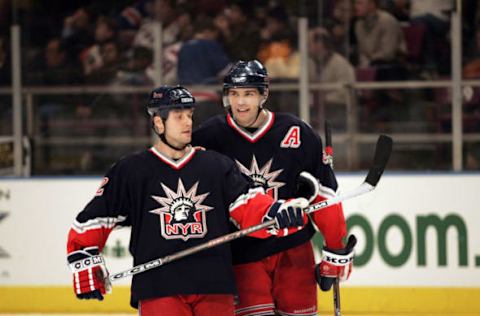
Since 1926 the New York Rangers have had many top lines. Some have had distinctive nicknames while others were notable for their excellence.
The New York Rangers came into the NHL in 1926. Throughout their history the club has had some productive and at times colorful forward line combinations.
We decided to come up with a list of the most notable line combinations of the Rangers storied history. There’s a whole list of lines made memorable by players names, chemistry or origin. Then we selected the top ten lines in team history, a list that will surely spark debate among Ranger fans. With 92 years of history to pick from, here is the criteria we used to make the selections:
- how long the line played together
- the overall production and accomplishments
- the contributions to the overall team’s success
- statistical contrasts comparable within their era
We’ll begin with some of the humorous and intriguing combos, more famous for their nicknames than their production.
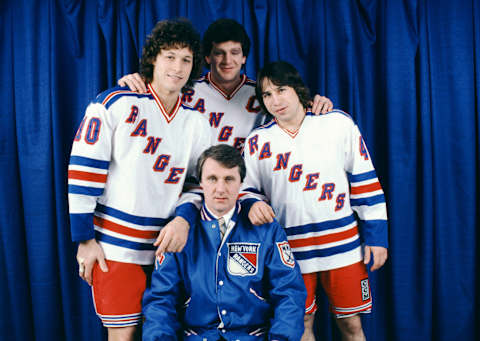
The catchy names
A list of memorable forward lines would not be complete without mentioning a few of the most entertaining combinations put together by Rangers coaches of recent memory.
The Battery line
Between the years of 2010-2012, Brandon Dubinsky, Artem Anisimov and Ryan Callahan formed the “Battery Line” which represented the players initials D-AA-C which also are for names of battery sizes. The trio was a solid two-way line and put up 161 goals over that span.
The HBO line
Between the years 2005-2007 the Rangers had some colorful characters who held down the fourth line. Centered by Blair Betts, wingers Ryan Hollweg and Colton Orr formed the “H-B-O” line that didn’t set many scoring records or score goals at all but they did lead the Rangers in penalty minutes during those years.
The Smurf line
Before the 1982-83 season the Rangers brought in Herb Brooks, the coach of the 1980 USA Olympic team of Miracle on Ice fame. With Brooks came some of the players from the gold medal team along with Brooks’ up-tempo weaving style. Brooks’ team that season were known around the league as “the smurfs” after the small and diminutive animated cartoon characters and children’s stuffed animals that lined toy stores around the country.
Former Olympians Mark Pavelich and Robbie McClanahan were paired with Anders Hedberg to form what became the “Smurf line”. The trio played a high pressure and energetic pace with pesky forechecking that drove opponents crazy. Their size didn’t reflect the offensive production they created on ice however. Pavelich led the way with 37 goals while Hedberg (25) and McClanahan (22) all finished among the team’s scoring leaders. Eddie Johnstone made an occasional guest appearance on the Smurf line during the playoffs as the Rangers upset the heavily favored Philadelphia Flyers 3-0 in the opening round.
That’s it for the list of lines whose monikers for the most part provided more notoriety than results. I’m sure that there are some we missed and feel free to add your favorites.
Let’s now look at the lines that couldn’t crack the top ten, but made honorable mention

Honorable mention – close but no cigar
Picking the top ten lines inevitably means that some outstanding trios don’t make the final list. Here are the honorable mentions, forward lines that were no slouches but were not quite good enough..
The Bones line
The 1950 New York Rangers may have finished in fourth place during the regular season but rode the hot hands of the Bones Line centered by Don “Bones” Raleigh, with wingers Ed Slowinski and Pentti Lund to the Stanley Cup Finals.
With Lund shadowing the great Maurice “Rocket” Richard and holding him to one goal, the Rangers dispatched the heavily favored Montreal Canadiens in five games. Lund, Slowinski and Raleigh combined for nine of the team’s 15 goals and 21 of the team’s 41 points.
Lund led all playoff scorers with 11 points while sharing top goal scoring honors with Slowinski and Detroit’s Sid Abel each scoring 6 goals. Raleigh had two overtime game winners in games four and five giving the Rangers a 3-2 lead in games before the Red Wings rallied to win the final two games and the Stanley Cup.
It’s no surprise that the Blueshirts lost the series. They had been kicked out of Madison Square Garden by the circus and had to play two “home” games in Toronto. Five of the seven games were played at Olympia Stadium in Detroit.
The Joker line
From 1971 to 1974 Pete Stemkowski centered the Rangers’ third line between Ted Irvine and Bruce MacGregor. Stemkowski, also known as the Polish Prince, was the team’s practical joker while Irvine was known for his flamboyant scoring celebrations and wise-guy attitude with opponents. MacGregor played the consummate role of straight man.
The trio were often called upon to stop the opponent’s top scoring line or shadow specific players. MacGregor was asked to negate Montreal’s Yvan Cournoyer or Chicago’s Bobby Hull. These strategic matchups were crucial but the line also contributed key goals including Stemkowski’s two epic OT goals in the 1971 Stanley Cup semifinals vs. the Blackhawks. MacGregor outscored Cournoyer in the 1974 quarterfinals as the Rangers disposed of the defending Stanley Cup champions in six games. As a third line they combined for 177 goals during their three plus seasons together.
Honorary Swede line
Before the 1978-79 season the Rangers signed Ulf Nilsson and Anders Hedberg as free agents from the WHA’s Winnipeg Jets. The Rangers experimented with several left wingers to play with the two Swedish superstars who were among the WHA’s top scorers playing with the legendary Bobby Hull. Pat Hickey settled in on the left wing slot as the honorary Swede to form the team’s number one line.
Hickey was coming off a breakthrough 40 goal the previous season and fit in superbly with Nilsson and Hedberg giving the Rangers two formidable scoring lines and power play units. Hickey had a career year with 34 goals and 75 points with eight tallies on the power play. Hedberg tied for the team lead in scoring with 33 goals and 78 points.
The playmaker in the pivot Nilsson was on a torrid pace averaging over a point per game showing the form that won him the scoring titles in the World Hockey Association. On a fateful night in late February at Madison Square Garden, Nilsson sustained a broken ankle after a collision with the New York Islanders’ Denis Potvin. Nilsson was never quite the same player but finished with 27 goals and 66 points in just 59 games leaving Ranger fans to memorialize Potvin at every home game since.
The FLY line
The Rangers came close to acquiring Eric Lindros in a blockbuster deal with the Quebec Nordiques before the1993 season however Lindros eventually arrived on Broadway in the summer of 2001 in a multiplayer deal with the Philadelphia Flyers. The Rangers also acquired high scoring winger Theo Fleury that summer via free agency. Rangers Coach Ron Low put 24-year-old Mike York on the left side with Fleury and Lindros to form the F-L-Y line.
The FLY line became a lethal combination of power and speed that became one of the most formidable scoring lines in the NHL during the 2001-2002 season. Lindros regained his dominant force in the middle after missing the previous season to injury. Lindros finished as leading scorer with 37 goals and 73 points with Fleury and York rounding out the top three scorers for the Rangers that season.
That’s it for the honorable mention. Time to turn our attention to the top ten forward lines in Rangers history.
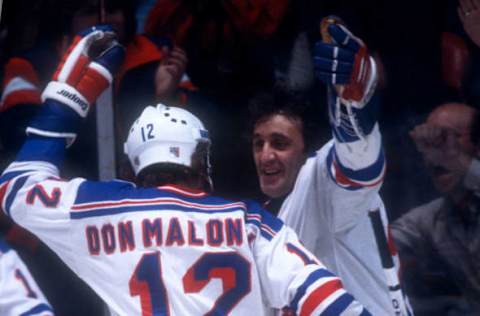
# 10 – The Godfather line
The 1978-79 Rangers got off to a quick start with their number one line of Ulf Nilsson, Anders Hedberg and Pat Hickey torching the league at a record pace. They received a shot in the arm when the NHL reinstated suspended winger Don Murdoch in January. Murdoch was put on a line with Esposito and registered a hat trick in his second game back. Second round draft pick Don Maloney was called up from New Haven to the Rangers and inserted as left wing with Esposito and Murdoch and became the Godfather Line; Esposito as The Godfather between the “two Don’s”. They became an instant hit.
With the loss of Nilsson for the rest of the regular season in late February, the Godfather line was elevated to the top spot. Maloney (9-17-26 in 28 games) was the line’s digger with Murdoch (15-22-37 in 40 games) as the sniping speedster anchoring the right side. The 36-year-old scoring machine Esposito drinking from a fountain of youth led the team in scoring (42-36-78 points) for the third consecutive season cracking the forty goal barrier for the first time in four seasons.
The Rangers advanced to the Stanley Cup finals that season largely on the backs of this newly formed dynamic trio. Esposito’s overtime goal in game two of the preliminary round eliminated the Los Angeles Kings. They then knocked off the Philadelphia Flyers in five games with the Godfather line scoring 10 of the 28 Ranger goals scored in the series including two game winners with Esposito the leading scorer of the series with 10 points.
Against the heavily favored Islanders, the Rangers pulled off the huge upset with the Godfather line scoring seven of the 18 goals scored in the series. Esposito notched the game winner in game three while the line set up Ron Greschner for the series clinching goal in game six. Maloney led all scorers in the semifinals with eight points and would set the rookie playoff scoring record with 20 points.
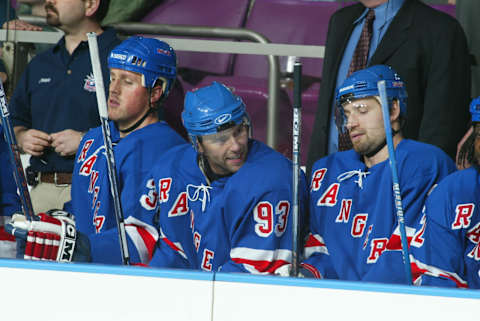
# 9 – The Czechmates
New York Rangers GM Neil Smith struggled to fill the void at center after Mark Messier was allowed to leave after the 1996-97 season. Needing a second line center with the sudden retirement of Pat Lafontaine, Smith reacquired Petr Nedved from the Pittsburgh Penguins in a trade for Alex Kovalev in November of 1998.
With the team missing the playoffs in back to back seasons and the retirement of Wayne Gretzky, Smith went to work to give Nedved some wingers and create a number one line. In June, he acquired left winger Jan Hlavac in a draft day deal with the Calgary Flames and then acquired right winger Radek Dvorak from the San Jose Sharks in December. Coach John Muckler put the wingers together with their fellow Czech Republic countryman Nedved and the Rangers had a number one line.
The unit became known as “the Czechmates” and quickly became a high flying production line with instant chemistry. The Rangers who at the time of the Dvorak trade were out of the playoff hunt went on a tear reeling off nine wins in 11 games with Nedved notching two hat tricks within a week and Dvorak scoring another giving them three within their first month together. The unit maintained its pace as Nedved finished as the team’s leading scorer with 68 points and Hlavac finishing ninth in rookie balloting for the Calder Trophy.
The 2000-01 season was the Czechmates finest showing. Nedved led the team in goals with 32 and finished second on the team in scoring with 78 points. Hlavac set career highs in goals (28) and points (64) and notched his first two NHL hat tricks and he led the team with six game winning goals. Dvorak also set career bests with 31 goals and 67 points and three game winners. Overall the Czechmates scored 91 goals with 14 of them game winning goals.
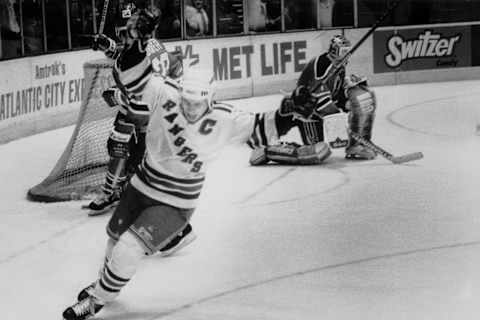
#8 – The Bread and butter line
Over the course of the three seasons (1987 to 1990) the Rangers relied upon their top line to regain respectability and a return to post season. Center Kelly Kisio had arrived via trade from the Detroit Red Wings in June of 1986 while GM Phil Esposito went out and acquired wingers John Ogrodnick from the Quebec Nordiques and native New Yorker Brian Mullen from the Winnipeg Jets. The trio was put together to assemble what became known as “the Bread and Butter line”.
The trio received their name from their workman-like approach and their gritty play in the tough areas of the ice. Mullen and Kisio were tough nosed scrappers while the quick and slender Ogrodnick was a breakaway threat who took advantage of the space created by his line mates. He also had a knack for getting to lose pucks, especially on the power play.
The “Bread and butter line” had their best season during the 1988-89 campaign which was also the furthest the Rangers got in the post season in their 3 seasons together. Ogrodnick was the Rangers leading scorer and topped all Rangers with 43 goals, the fourth time he topped the 40 goal plateau in his career. Nineteen goals were on the power play, and he had a team leading eight game winners. It was an all star season for Ogrodnick who added 6 goals in the playoffs.
Mullen had his third consecutive 25 goal season and finished second in scoring with 68 points. Mullen had seven goals on the power play and three game winners. Captain Kisio finished fourth in scoring with 66 points despite missing 12 games. Of his 22 goals, seven of those were on the power play and finished third in playoff scoring with 10 points. The trio combined for 92 goals and 12 game winning tallies.

#7 – The Bulldog line
During the early seventies the hype around Rangerstown was the goal a game line of Jean Ratelle, Vic Hadfield and Rod Gilbert. We’ll get to the GAG line within this tribute list however during the 1969-70 season Emile Francis assembled the trio of Walter Tkaczuk, Bill Fairbairn and Dave Balon which became known as “the Bulldog line”. The Bulldog line went through some metamorphosis with the left wing spot but the two constants were Tkaczuk and Fairbairn.
Tkaczuk, the stoic centerman came up through the Rangers farm system and debuted in 1968-69 as one of Francis’ development chips. Fairbairn arrived in New York as a rookie the following season as a hard working winger known for his relentless work along the boards and replaced the injured Bob Nevin with Tkaczuk and the veteran Balon. In their first year the Bulldog line actually outscored the famed GAG line putting up 203 points with Tkaczuk leading the team in scoring, Balon the team’s leading goal scorer with 33 markers, and Fairbairn finishing second in the Calder trophy balloting for rookie of the year.
Balon, the veteran from Saskatchewan had his two best seasons finishing in the top ten goal scorers in the league, but eventually his play level showed signs of decline which would later be diagnosed as the onset of multiple sclerosis was traded during the 1971-72 season. A season ending injury to Ratelle forced Francis to scramble his lines with Tkaczuk taking on additional roles within the mix.
Left winger Steve Vickers arrived on the scene during the 1972-73 season and found a home as the new left winger with 30 goals enroute to rookie of the year honors. Fairbairn had a career high 30 as the Bulldog line struck for 87 goals with 17 game winners. Vickers had three hat tricks including the first back-to-back hats as a rookie in NHL history. Tkaczuk and Fairbairn continued to shine as the top penalty killing pair in the league. They played their last year together in 1973-74 with Vickers hitting the 30 goal mark again before being moved to the top line with Ratelle and Gilbert the following season.
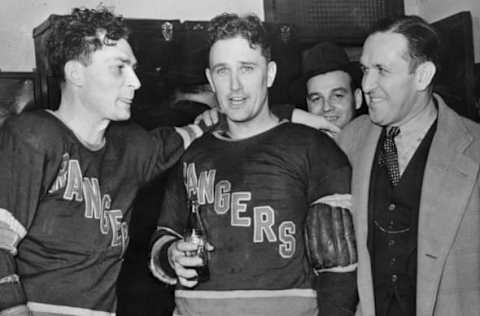
# 6 – 1940 – A Stanley Cup champion line
The New York Rangers of the early forties were coached by the legendary Frank Boucher. During the seasons 1939 to 1943 the Rangers would be among the league leaders each season led by Hall of Fame wingers Bryan Hextall and Lynn Patrick on the top line with fiery Phil Watson at center. The trio didn’t have a nickname per se but they were among the highest scoring lines of the era.
Hextall was one of the first “off-wingers” as a left shot playing the right side was the last Rangers player to lead the league in scoring with 56 points during the 1941-42 season. Patrick would be the last Rangers player to lead the league in goal scoring that same season with 32 goals in 48 games. Watson had his best season that same season leading the league in assists with 37. Hextall led the league in goal scoring during the 1939-40 and 1940-41 seasons.
It was during the 1939-40 season that the Rangers would win their third Stanley Cup and their last for the next 54 seasons. The Rangers beat the Toronto Maple Leafs in six games and the Hextall/Patrick/Watson line led the way. Center Watson was the top scorer with nine points in 12 games. Hextall had a hat trick in game two of the finals in a come from behind win over Toronto before scoring the overtime game and cup winning goal in game six.
Despite the line’s success, the Rangers could not get past the first round of the playoffs in subsequent years. The trio was separated by World War II enlistment obligations and would not play again together after the 1942-43 season.

#5 – Two Czechs and a Swede
The New York Rangers emerged from the NHL Lockout having missed the postseason in seven consecutive seasons. Following the 2003-04 season the Rangers had completed a fire sale of the high-priced veterans that made up the team’s roster, as well as the retirement of long-time captain Mark Messier. They had acquired all star winger Jaromir Jagr from the Washington Capitals. Having few other NHL players on their roster many experts had projected the 2005-06 Rangers to be the worst team the NHL.
Jagr played in the KHL during the lockout and came into training camp with a lot to prove. GM Glen Sather scoured the free agent rolls and came up with a few stop gaps but the Rangers were going to rely upon young players to fill the lineup card. Among the free agents brought in to play with Jagr on the top line were Swedish veteran center Michael Nylander and Jagr’s fellow countryman from the Czech Republic Martin Straka. Despite the roster depth challenges, Jagr made the bold prediction that the Rangers would make the playoffs and he would make good on it.
Jagr started strong during the beginning of the season becoming only the fourth player in NHL history to score ten or more goals within the first ten games of a season. He finished the year breaking the Rangers single season records for goals (54) and points (123). Jagr regained his dominant form with 24 goals on the power play and 9 game winners as the Rangers amassed 100 points. Jagr finished second in the NHL in goal scoring and points, and was awarded the Lester B. Pearson Award as the league’s most outstanding player, while finishing as runner up for the Hart, Richard and Art Ross Awards.
The Nylander-Jagr-Straka line would combine for 97 goals which was 39% of the team’s goal production with 17 game winners accounting for nearly 40% of the Ranger victories. Centerman Nylander had a career best 56 assists and 79 points with Straka chipping in with 22 goals and 76 points.
The trio had a stellar repeat the following season even though Jagr failed to break the century mark with 30 goals and 96 points. Nylander set new career bests with 14 game winning goals, 57 assists and 83 points. Straka finished with 29 goals and 70 points as they repeated as the top 1-2-3 in team scoring. They combined for 29 game winning goals almost half of the team’s victories and led the resurgent Rangers to the conference semifinals.
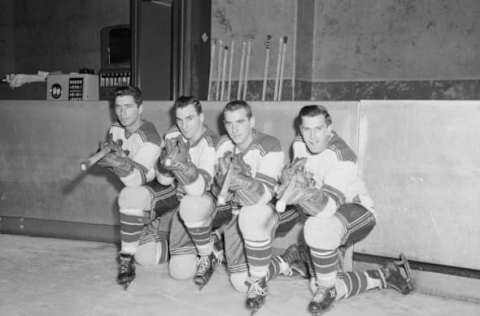
Andy Bathgate, Larry Popein and Dean Prentice
The New York Rangers were not a very good hockey club during the late1950’s through the the late 1960’s. They often missed making the playoffs or went the one round and out route during the decade. The team had some formidable and beloved talent but their marquee player was perennial all star Andy Bathgate who’s nickname at the time was “Tubby” which was a play off his last name (bathtub).
Bathgate was a sniper deluxe of the league and arguably one of the greatest Rangers of all-time setting team records during his tenure in New York. He remains the team’s fourth all-time scorer in goals, assists and career points. The smooth skating right winger stormed opponent’s defenses with his deceptive speed and terrorized NHL goalies around the league with his wicked shot. Many attribute Bathgate for goaltenders donning face protection after decades of playing without. He played on the Rangers top line which featured Larry “the Pope” Popein at center with Dean Prentice on the left wing.
Bathgate and Prentice played together on the Guelph Biltmores of the Ontario Junior league while Popein, the stoic, fearless, hard-working center was a product of the western Canada junior leagues. Prentice, the line’s most underrated player, became a solid two-way standout who excelled at backchecking, killing penalties, and working the corners. Prentice and Bathgate would garner the lion’s share of points while the unassuming Popein became known as the scoreless pivot.
The line had its most success during the late fifties as Bathgate would break all then Rangers single season and all-time scoring records while winning the Hart Trophy as the league’s most valuable player during the 1958-59 season. Bathgate remained among the league leaders in scoring for seven consecutive seasons while Prentice also entered the top three in goal scoring as he led the team with 32 goals during the 1959-60 season. Ironic that the team’s fortunes were not as prolific as the scoring of this line missing the playoffs in four of their five best seasons together.
And now on to the top three.
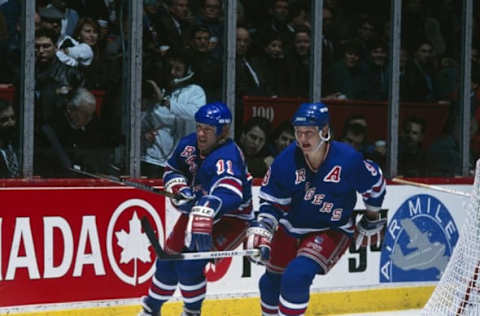
# 3 -The Messier line
New York Rangers GM Neil Smith made perhaps the biggest trade in franchise history when he acquired Mark Messier just after the beginning of the 1991-92 season. It was a trade that made the Rangers a credible contender and changed the the face and fortunes of the franchise forever. Messier had won five Stanley Cups with the Edmonton Oilers and was brought in to deliver one to New York.
Messier was a power forward who combined speed and grit and then added the playmaking dimension of finesse and vision. He had a rough and tumble exterior meshed with a competiveness and leadership that made him among the most complete hockey players in the history of the game. Messier not only was the master of every aspect of the game but had the swagger to make all others around him better.
The Messier line had one constant member in Adam Graves who would hold down the left wing position throughout Messier’s first tour of duty with the Rangers. Graves brought a relentless work ethic, corner toughness balanced with scoring touch. The Messier and Graves combination was an unstoppable force. The right wing spot however was a revolving position.
Tony Amonte was the first right side resident as a 21-year-old rookie. His game breaking speed stretched opponents and his gifted hands buried 35 goals And finished as the Calder Trophy runner up. Messier broke the century mark with 107 points and captured the Hart Trophy as league MVP in 1991-92 when the unit combined for 96 goals. The following season they combined for 94 goals with Graves leading with 36 markers.
In the 1993-94 season, Graves would set Rangers season record with 52 goals. Amonte was dealt at the trade deadline which provided the opportunity for the mercurial Alexei Kovalev to showcase his talent with the top line. The infusion of Kovalev jumpstarted the line in the playoffs and the Rangers rode their energy to capture their first Stanley Cup in 54 years. The line finished 2-3-5 in playoff scoring with 30 goals and 67 points in 23 playoff games.
Pat Verbeek made his debut on the Messier line after a late season trade with the Hartford Whalers during the strike-shortened 1994-95 season and fit right in. The trio clicked for 21 goals in 19 games with 11 goals in 10 playoff games. The following season the line struck for 110 goals with Verbeek and Messier both topping the 40 goal mark. The line added 28 points in 11 playoff games.
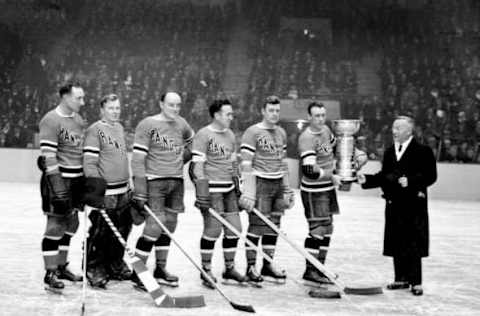
# 2 -The Bread line
The first great scoring line for the Rangers was the Bread line of the late 1920’s and 1930’s. The line featured brothers Bill and Bun Cook with the mild mannered Frank Boucher at center. The Bread line brought crowds to their feet way with their dazzling speed, beauty and criss-crossing style which was unique at the time. Difficult to anticipate and defend, their style is thought to have been the basis by which teams from Russia became known for decades later. The Cook Brothers and Boucher were all inducted in the NHL Hockey Hall of Fame
The line dominated games as evident by scoring every goal of a five game Stanley Cup winning series in 1928. Bill Cook was the line’s goal scorer, a burly right winger with flashy moves. He scored the first goal in New York Rangers history and led the NHL in goal scoring three times. Cook remains the all-time leader in hat tricks with 9 despite never playing 50 games in a season. He scored the overtime Stanley Cup winning goal in the 1933 and served as team captain for eleven seasons.
His brother Bun was the key to the attack with intricate passing and the ability to move and pass into an open space. He also was no stranger to mucking it up in the corners. Boucher was perhaps the best of the three players, orchestrating the attack with brilliant playmaking skills which often resulted in one of the Cooks pushing the puck into the open net.
Boucher is regarded as the franchise’s greatest player of the pre-War era leading the league in assists three times. He held the Rangers career scoring record until 1959. With statistical weighting for games adjusted, Boucher would be the franchise leader in assists and points. Boucher was also a perennial winner of the Lady Byng trophy for gentlemanly play. He was given permanent possession of the trophy after winning it in seven of the first eight seasons in which it was awarded.
And now for the #1 line in Rangers history…
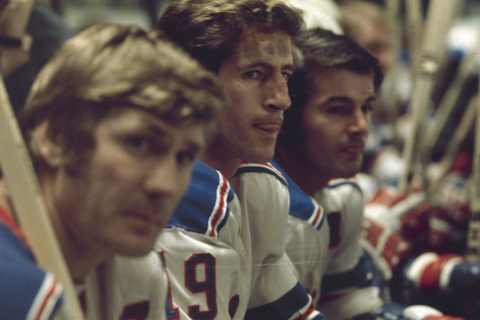
# 1 -The GAG line
Emile Francis put three players together during the 1968-69 season who had been with the club over parts of the previous six seasons. Jean Ratelle a tall slender center had played his junior hockey with his childhood friend Rod Gilbert on his right side. Francis realized that the pair lacked some muscle and put Vic Hadfield on the left side and the trio would stay together for the next six seasons.
What Francis did was create one of the legendary lines in Rangers history, as well as one of the most prolific forward units in National Hockey League history. They were given the name GAG line which stood for goal-a-game and they stayed together through the 1973-74 season during which each member would score 20 or more goals in with the exception of one. Ratelle and Gilbert were consistently among the top ten in league scoring goals and assists with Ratelle in the top ten in scoring five out of six seasons.
During the 1971-72 season they enjoyed their finest season of all. They combined for 312 points that year. Ratelle (109 points), Hadfield (106) and Gilbert (97) finished. 3-4-5 in NHL scoring, and likely would have all topped 50 goals had Ratelle not broken his ankle in March with 15 games remaining. Hadfield became the first Ranger ever to score 50 goals in a season, while Gilbert scored 43 and Ratelle 46 in only 63 games. All three players were named to the all NHL team with Gilbert first team right winger.
Perhaps the most impressive statistic of the line’s production during their magical season was that 104 of their 139 goals came at even strength. In addition 17 game winning goals represented 35% of the team’s victories. Fifteen 20 plus goal seasons and seven seasons of 30 goals or more. During their six seasons they totaled 545 goals, 774 assists and 1,319 points. Ratelle and Gilbert are members of the NHL Hall of Fame. All three players have their jerseys retired and hanging in the rafters at Madison Square Garden.
Of the top five goal scorers in Rangers history, three of them come from the GAG line with the top two being Gilbert (406) and Ratelle (336) and Hadfield No. 5 with 262 goals. With present day lines not kept together as regularly, the GAG line’s production is likely to remain the Rangers all-time best.
So there you have the top ten Rangers forward lines. If you have some suggestions on lines that were missed please mention them in the comments.
Special thanks and acknowledgement:
“Before 94: The Story of the 1978-79 New York Rangers”
by Mark Rosenman & Howie Karpin
“We Did Everything But Win: Former New York Rangers Remember the Emile Francis Era (1964-1976)”
by George Grimm